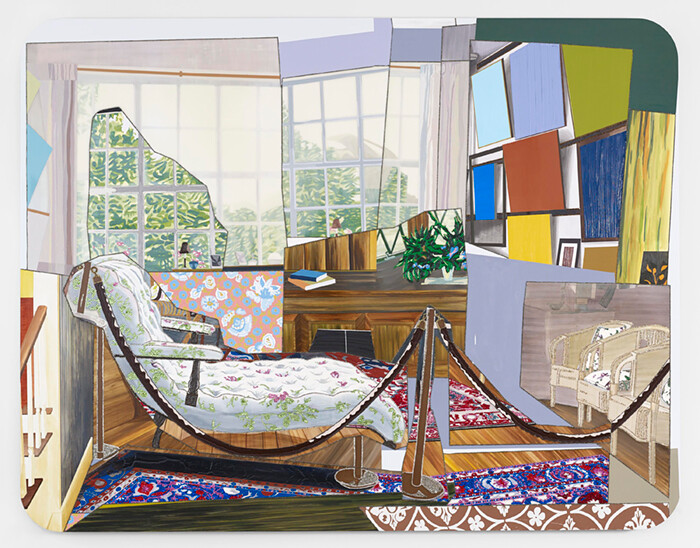Mickalene Thomas first gained acclaim with her stunning painted portraits of African-American women. She easily could have continued producing this kind of portraiture work à la Chuck Close or Kehinde Wiley and become quite successful in a similar way; instead, she has restlessly explored a variety of genres and mediums—including photography, installation, collage, murals, film, and video—while retaining her signature style. Concurrent with a large solo exhibition at the Brooklyn Museum, her work is showing at both of Lehmann Maupin’s New York City locations under the title “How to Organize a Room Around a Striking Piece of Art.” At the Lower East Side venue, new paintings resulting from time Thomas spent at Claude Monet’s house and garden in Giverny, France, are on display. Each employs the fractured picture plane, swathes of bold color, and embedded rhinestones common to Thomas’s work; if anything, absent the faces that previously dominated, these qualities become even more pronounced.
In her portraits, rhinestones outline shapes or sparkle in the jewelry worn by her depicted subjects, but in Monet’s Salon (all works 2012) red rhinestones cluster in a rug’s gorgeous detailing. This interior view reflects an image seen in the first piece gallery-goers encounter—a video looped partially out of synch on five small tablets embedded in wooden frames. Filled with brief shots and slow pans of flowers, a candle, an eggshell, as well as interiors of Monet’s house and Thomas walking through the garden, Majestic Landscape serves as a digital sketch for the four paintings that follow. Interior: Monet’s Blue Foyer is a billboard-size canvas that combines three separate rooms. In both paintings featuring the inside of Monet’s house, Thomas collapses foreground and background and offers a fragmented perspective that owes much to experiments in nineteenth-century French painting (especially Paul Cézanne), but more tellingly points to all of her works’ carefully collaged, synthetic quality.
Similarly, in the two landscapes on display, one of which tilts back as if propped on an enormous easel—i.e., faux plein air—the vista collapses into bands of thick paint, images of water lilies, rhinestone-encrusted flowers and leaves, and chunky monochrome blocks. The sense of artifice in Thomas’s work is among its most notable features, and serves to complicate the most obvious readings of her art as primarily consisting of relatively straightforward portraits, and more recently landscapes and interiors. In fact, what she creates isn’t just a world but an entire universe—to echo the play on the title of Gustave Courbet’s L’Origine du monde (1866) that serves as the name of Thomas’s exhibition at the Brooklyn Museum, Origin of the Universe (where she provocatively updates Courbet’s notorious painting as well). In this imaginatively fabricated universe, clusters of Thomas’s own work, friends, family, artists, and influences form constellations around which to compose stories and personal narratives.
This becomes more clear in Lehmann Maupin’s Chelsea space where Thomas has installed something of a memorial to her mother, Sandra Bush, who passed away this year. The first gallery contains seven new color photographs of Bush, who also modeled for Thomas in the past. Posed in sets invoking the 1970s—as much of Thomas’s portraiture attempts to do, whether in its fashions or palette—Bush reclines on a couch, sits erect, stands with a smile, and, in a rare moment of misgiving in Thomas’s entire oeuvre, looks to the side a bit anxiously. These are the types of photographs from which Thomas in turn derives her painted portraits. Three smaller images have the feeling of more casual snapshots, while seeming to draw attention to the wig Bush wears. (Signaling the degree to which personas are constructed and performed, Thomas’s models usually wear wigs.)
Screening in the second gallery is a touching twenty-three minute biographical video of her mother entitled Happy Birthday to a Beautiful Woman (the video also concludes the Brooklyn Museum show). Chronologically organized, the work combines intimate interviews Thomas conducted with her mother, stills of family photographs, and clips from popular culture (Bush had once been an aspiring singer and a professional model) in an attempt to convey her triumphs, failings, and perseverance. Viewers are encouraged to watch the video from within an expanded version of one of the sets Thomas builds for her photographs, and which she has started to display as artworks in their own right. The mismatched upholstered fabric, fake wood paneling, and jigsaw puzzle tiled floor again connote the 1970s, even if the approach to interior design is here more reimagined than real, and in this sense not so far removed from her painted interiors of Monet’s house, however distant in time, place, demographics, and class.
This points to an important tension in Thomas’s work, one frequently overlooked or ignored. The material world is recalcitrant, which is why art will never fully behave. It can be secured in museums or tucked away inside the palaces and homes of collectors, but a direct encounter with the work of art always has the potential to unsettle, which has less to do with themes and content. Controversies, after all, eventually diminish with time. Even though Thomas’s art is relatively straightforward in what it depicts, its visually unstable surfaces, reliance on the artificiality of rhinestones as structural signifiers, flattened vectors, and collaged bodies and objects constantly shift the viewer’s perspective, adding instabilities of meaning to the nevertheless central one of representation.





